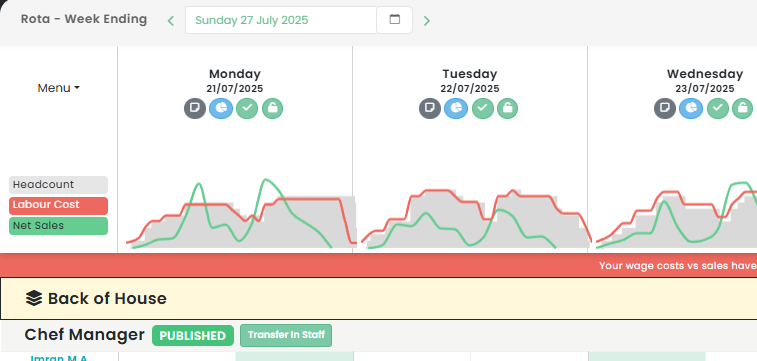Maximising Restaurant Profit Margins in the UK: Tips and Strategies
Stay informed with industry news, tips, and practical guides for hospitality professionals.
In the competitive world of UK hospitality, profit margins can often feel razor-thin. With rising costs of ingredients, labour, and utilities, restaurants face a constant battle to stay profitable. At Opsyte, we understand the pressures hospitality businesses endure, which is why we’ve developed tools to simplify and streamline management processes. In this blog, we’ll explore how restaurants in the UK can maximise their profit margins and thrive in an increasingly challenging market.
What Are Typical Profit Margins for UK Restaurants?
The average restaurant profit margin in the UK typically falls between 2% and 6%, though top-performing establishments can achieve upwards of 10%. These margins depend on several factors, including location, cuisine, and operational efficiency. For most restaurant owners, the key to success is finding ways to increase revenue while controlling costs effectively.
5 Ways to Improve Your Restaurant’s Profit Margins
1. Analyse and Optimise Your Menu
Your menu is your business’s core revenue generator. A poorly priced or overcrowded menu can eat into your profits.
- Menu engineering: Identify your most profitable and popular dishes and highlight them.
- Streamline offerings: Reduce low-margin or low-demand items to save on inventory costs.
- Seasonal specials: Leverage seasonal ingredients that are cost-effective and in abundance.
2. Control Food and Beverage Costs
The cost of goods sold (COGS) is one of the largest expenses for restaurants. Reducing waste and negotiating better deals can make a significant difference.
- Track inventory meticulously: Use software like Opsyte to monitor inventory and reduce waste.
- Portion control: Train staff to serve consistent portions to avoid overuse of ingredients.
- Supplier relationships: Negotiate bulk discounts and compare pricing regularly.
3. Optimise Labour Efficiency
Labour is another significant cost. Balancing staff coverage with service quality is critical.
- Forecast demand: Use data to predict busy and quiet times, scheduling staff accordingly.
- Cross-train employees: Equip staff with multiple skills to provide flexibility during shifts.
- Automate admin tasks: Opsyte’s staff management tools reduce the time spent on rota planning and payroll, allowing managers to focus on guest experience.
4. Enhance Operational Efficiency
From the kitchen to the front of house, inefficiencies cost time and money.
- Technology integration: Invest in software that automates tasks like invoice processing and reporting.
- Energy savings: Implement energy-efficient appliances and monitor usage to reduce utility bills.
- Streamlined workflows: Regularly review and refine processes to minimise delays and errors.
5. Boost Revenue with Upselling and Marketing
Maximising sales is just as important as controlling costs.
- Upselling strategies: Train staff to suggest premium options or add-ons to boost average spend per customer.
- Loyalty programmes: Encourage repeat visits with incentives for regular customers.
- Targeted marketing: Use social media and email campaigns to reach your audience effectively.
The Role of Technology in Profitability
In today’s fast-paced industry, technology is no longer optional – it’s essential. Software like Opsyte helps restaurants simplify tasks like invoice processing, staff scheduling, and reporting, saving time and reducing costly errors. By investing in the right tools, restaurants can focus more on delivering exceptional dining experiences and less on administrative headaches.
Conclusion
While the challenges facing UK restaurants are significant, there are clear strategies to improve profit margins. By optimising your menu, controlling costs, and using technology to streamline operations, your restaurant can not only survive but thrive in today’s competitive market.
At Opsyte, we’re passionate about supporting hospitality businesses with software designed to make management easier and more effective. Want to learn more? Contact us today to see how Opsyte can help boost your restaurant’s profitability.
Ready to simplify hospitality ops?
We’ve got you.
Speak with an Opsyte expert to see how we help:
- Save hours on staff scheduling and rota planning
- Automate invoice processing and financial insights
- Track live labour costs vs sales in real-time
- Get fast answers and support from real humans
- Automate your P&Ls

“Opsyte transformed our entire back office. Game changer.”
Read articles from our hospitality experts
-
Leveraging Catering Software for Efficient Event Management in the Hospitality Industry: A Comprehensive Guide to Optimizing Event Catering, Online Booking, and Food Service with Advanced Catering Tools and Solutions
Revolutionising the Hospitality Industry with Catering SoftwareIn today's rapidly evolving digital landscape, the hospitality industry is not left behind. The integration of technology, notably catering software, is transforming the way…...
-
Maximising Your Profit: A Comprehensive Analysis of Average Gross Profit Margin in the Restaurant Industry
A Comprehensive Look at the Average Gross Profit Margin in the Restaurant IndustryThe hospitality industry is a dynamic and challenging sector, and nowhere is this more evident than in the…...
-
Mastering the Art of Bar Advertising: Innovative Strategies for Hospitality Marketing and Sales Growth
Revolutionise Your Hospitality Business with Innovative Bar Advertising IdeasTransforming your bar into a bustling hub of social activity calls for an expert blend of traditional hospitality marketing and savvy digital…...
-
Optimising Restaurant Shifts: Effective Management and Scheduling Strategies for the Hospitality Industry
Mastering Restaurant Shift Management: A Key to Success in the UK Hospitality IndustryIn the ever-evolving landscape of the UK hospitality industry, effective restaurant management has never been more important. A…...
-
Innovative Bar Business Ideas for Success in the Hospitality Industry: A Comprehensive Guide to Bar Management, Marketing Strategies, and Profitable Concepts
Bar Business Ideas: Innovations and Trends in the UK Hospitality IndustryRunning a successful bar business in the UK hospitality industry requires innovation, effective bar management, and keeping abreast of the…...
-
Innovative and Successful Pub Event Ideas: A Comprehensive Guide to Planning, Managing, and Promoting Events in the Hospitality Industry
Event Ideas for Pubs: Revitalising the UK Hospitality IndustryIn the bustling landscape of the UK hospitality industry, pubs have remained a staple of British culture. From friendly local establishments to…...
